- in Production by Bobby Owsinski
Miking Horns With Trumpet Legend Jerry Hey

Engineers that don’t work with horn players much often don’t understand the difficulties or the technique for getting a great sound. Here’s an interview with Jerry Hey, who may be the most widely recorded horn player ever, from my Studio Musician’s Handbook that explains things from the player’s point of view.
Bobby Owsinski: I understand that you have strong feelings about how people mike your horn.
Jerry Hey: I guess I have strong feelings because over the course of my experience, being in great situations and being in awful situations, I’ve learned a lot.
You carry your own mics, don’t you?
I have for about 10 or 12 years. When you go into studios like Capitol or Oceanway, they have a good microphone collection so you don’t have to worry. But with home studios being such a big part of recording now, a lot of times they don’t have any good mics. It forced me to take one part of the equation and make it the same every time so that I always know that it’s not the microphone’s fault if something doesn’t sound right. I carry 3 Royers (model R-121) with me now.
Why 3 Royers?
Usually in my horn section there are 2 trumpets, one trombone and one sax. The trumpets play on one mic, and trombone and sax play on a mic each. The Royer has become sort of a standard for horns now. Most of the studios now have bought them so I don’t have to even take them in to a lot of places.
So do you just have someone use your mics right away or do you wait to see what it sounds like?
It depends on the engineer. For instance Bruce Swedien has a great mic collection that he bought new that no one else has ever touched, and he’s put a whole host of microphones in front of us. We did a very high intensity tune for Michael Jackson once where he put his RCA 44 on the trumpets and I told him “Bruce, you’re the only guy that I’d ever let put that microphone in front of us”. He said, “Wait until you hear it”. It just sounded amazing because it was in such pristine condition. In a situation like that where a guy has world-class microphones, there’s usually not a problem. But in situations where I’m in somebody’s home and they have little or no microphone selection and they put up something that I know doesn’t sound good, I’ll tell them I have the Royers available.
Do you have a favorite placement?
Because the Royers have a figure 8 pattern, the room is an issue in the placement. If you’re in a smaller room with 4 horns, you can’t have the mics too far away from the trumpets at the level we play because the room becomes a factor on the back side of the mic. So the placement can be anywhere from a foot and a half to 4 feet or so away. We’ve done some Earth, Wind and Fire stuff where it’s been 6 feet away. That was kind of roomy because the room was small but that was that sound that we were going for; kind of a “live” kind of sound. So it does depend on the size of the room and how far away you are from the wall that you’re playing toward and how much slap off the wall you’re going to get. But generally I’d say about 2 feet from the end of the trumpet bell takes most of the room away from it.
How do you determine where in the room you’re going to play?
That depends on the acoustics of the room. In a moderate size room like Oceanway, Conway or Capitol, when you play soft it sounds like you’re playing soft and when you play loud it sounds like you’re playing loud and you can hear yourself all the time. Almost anywhere in those rooms sounds great. If you go into another room that has carpeting on the floor or soft walls or ceilings, the quality of sound doesn’t change that much (from soft to loud) and you feel like you have to work harder. In a deader room it helps to be closer to a wall so you can get a little feedback from what you’re playing otherwise it’s easy to overblow and work harder than you need to work.
Do you mean play into the wall?
Not into the wall but move a step or two closer to get a little bit of feedback. When you’re playing trumpet your effort is a factor on how much you can hear yourself so in a deader studio it makes it a lot more difficult to play and to hear everybody. So if you move up a little closer to the glass or the wall, it can make you not work so hard.
Does that still matter if you’re wearing headphones?
We always us one sided headphones because it’s very difficult to expect the engineer to get your balance good enough with the rhythm section, and also balance the horn section the way it should be in order to play in tune with double-side phones. That puts another cog in the link of recording when you have to make the engineer work that hard. Also, with one headphone we can hear everyone in the room which helps keep the time and phrasing the same.
You can read more from The Studio Musician’s Handbook and my other books on the excerpt section of bobbyowsinski.com.

